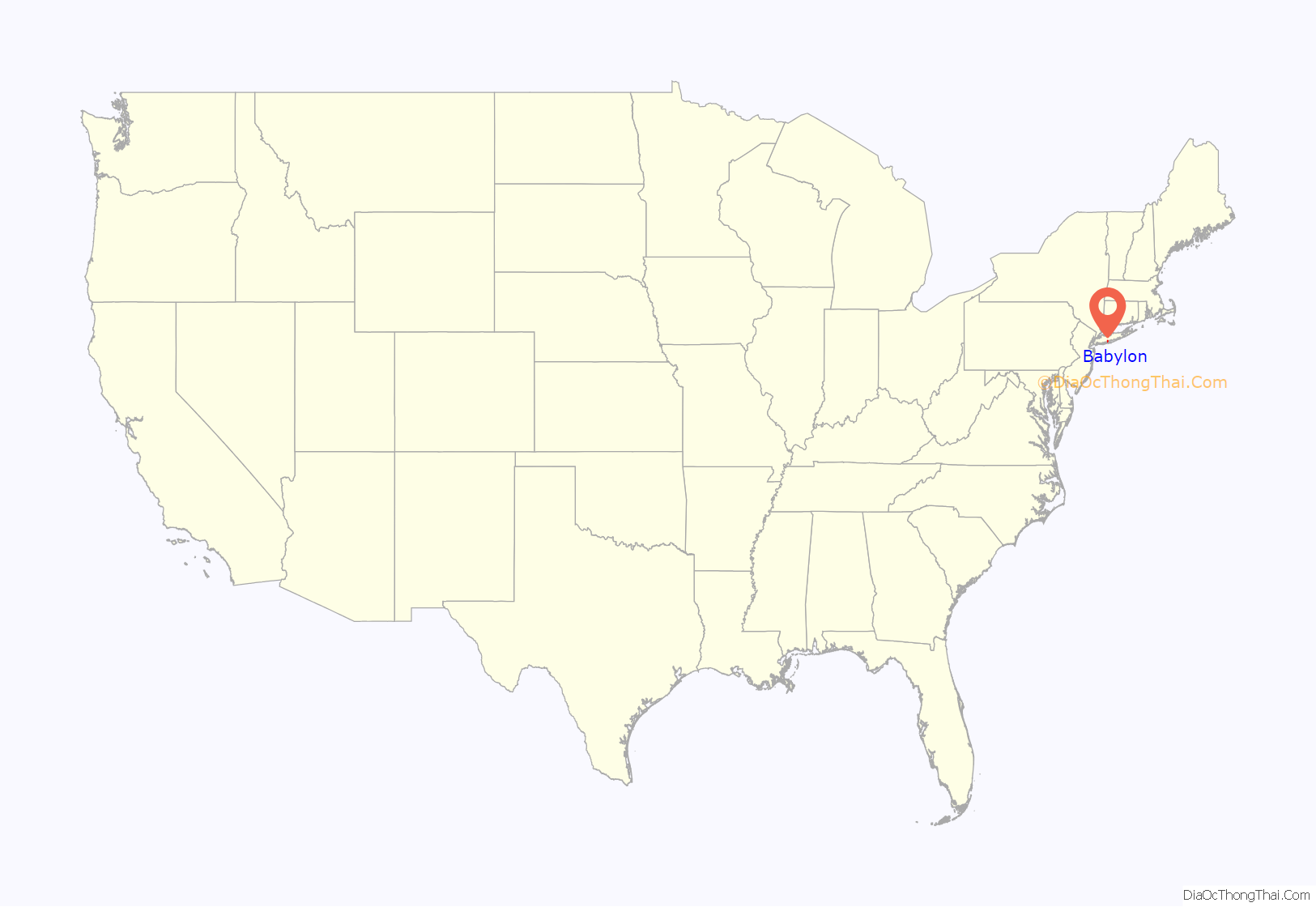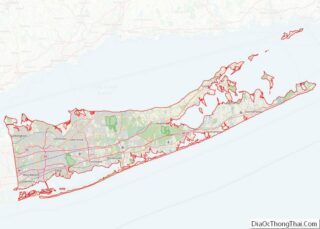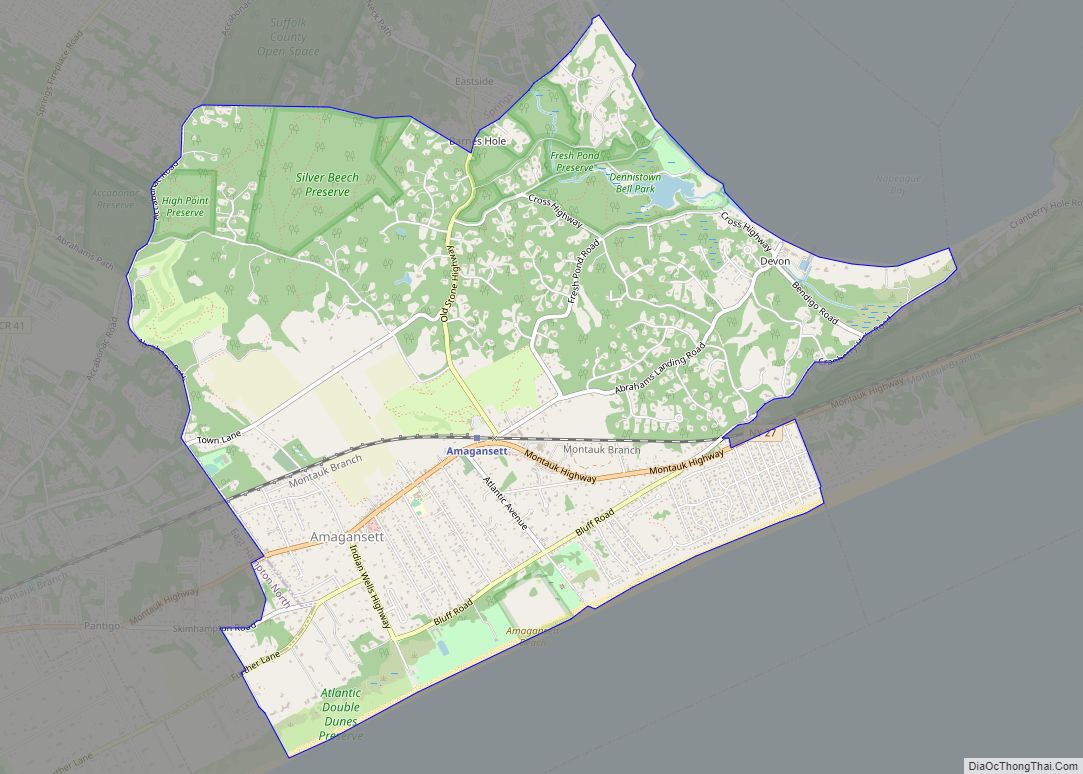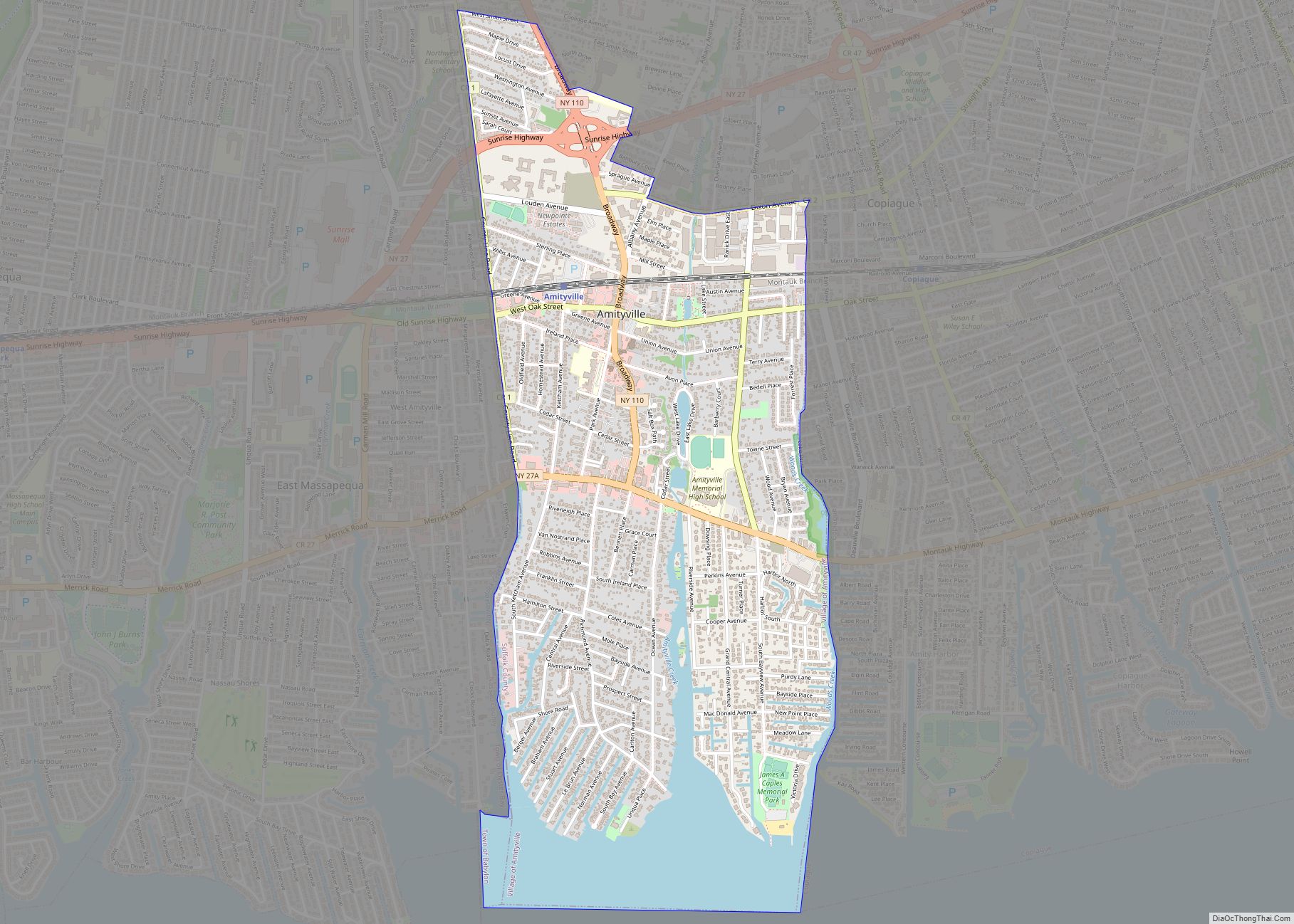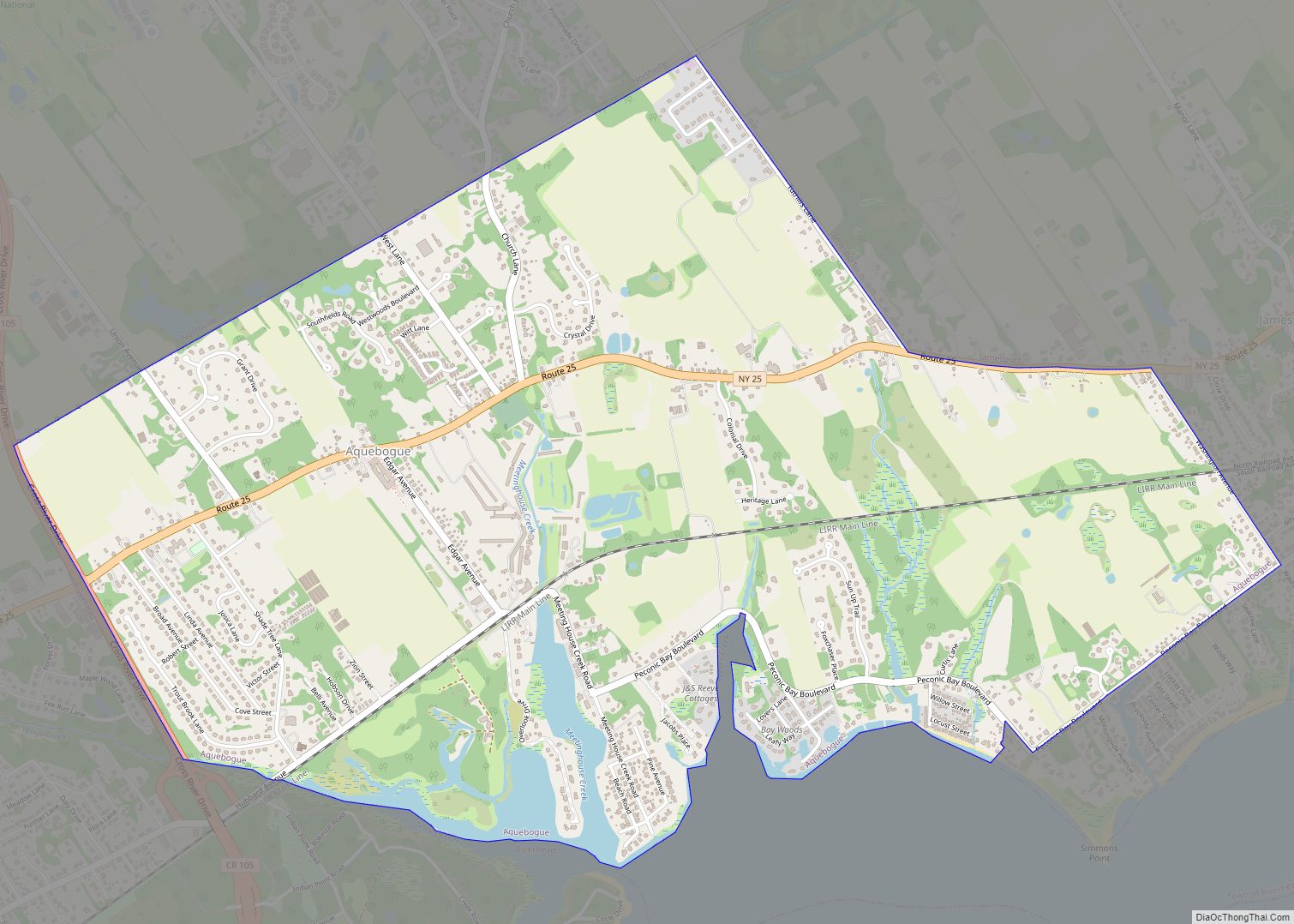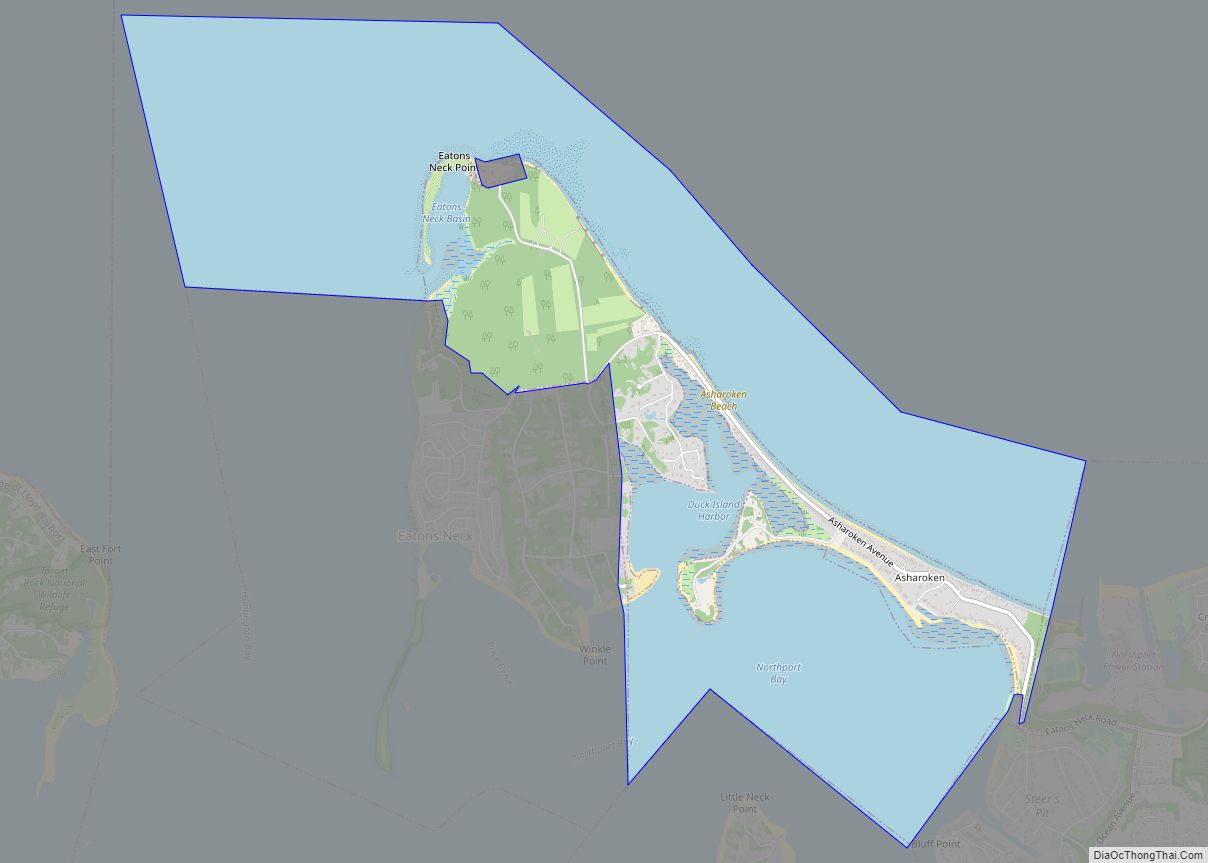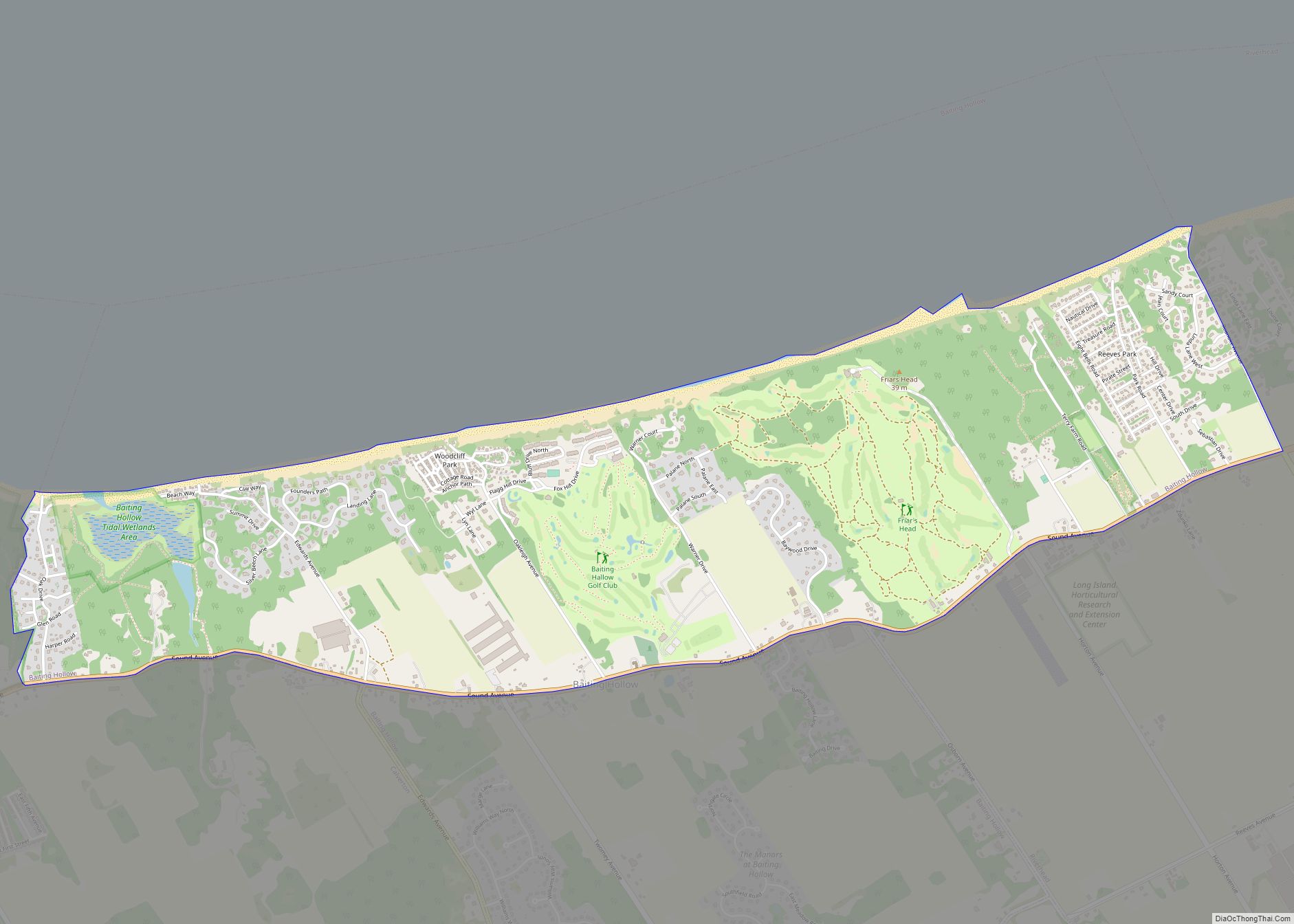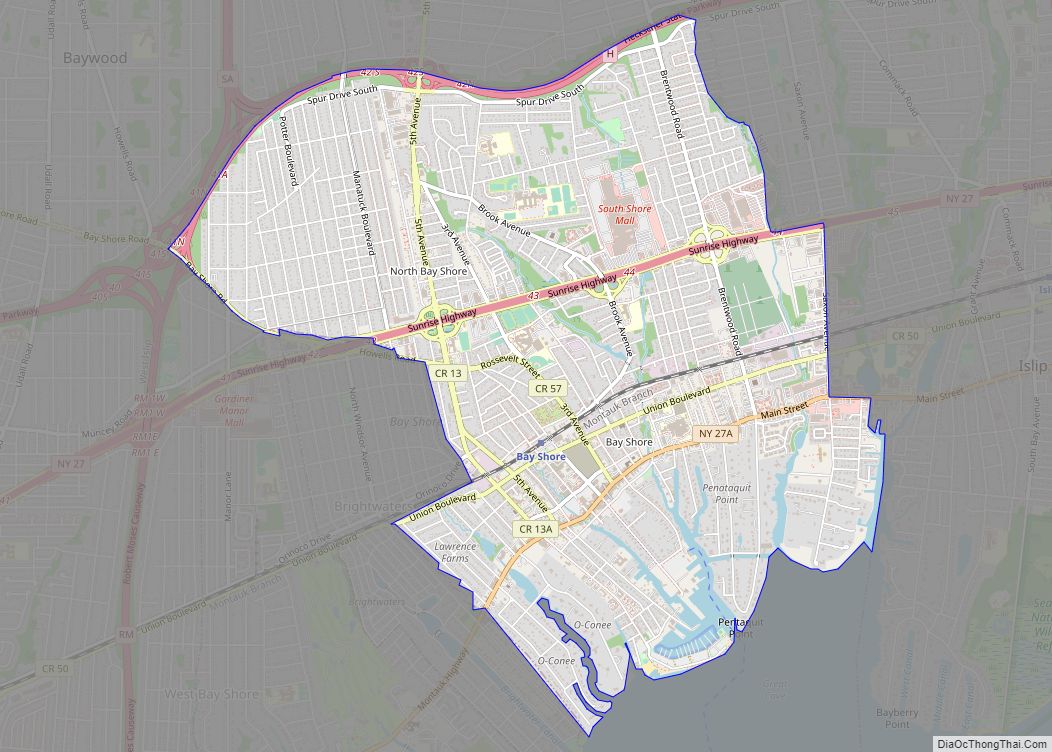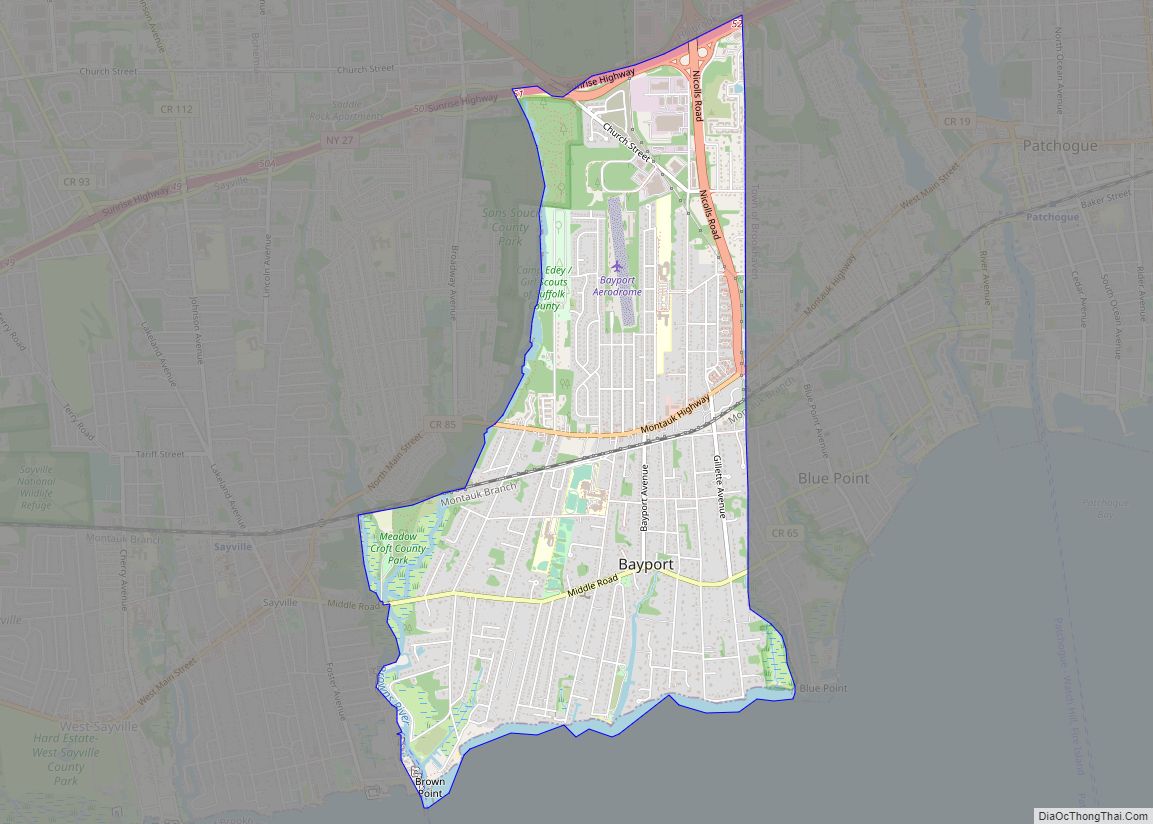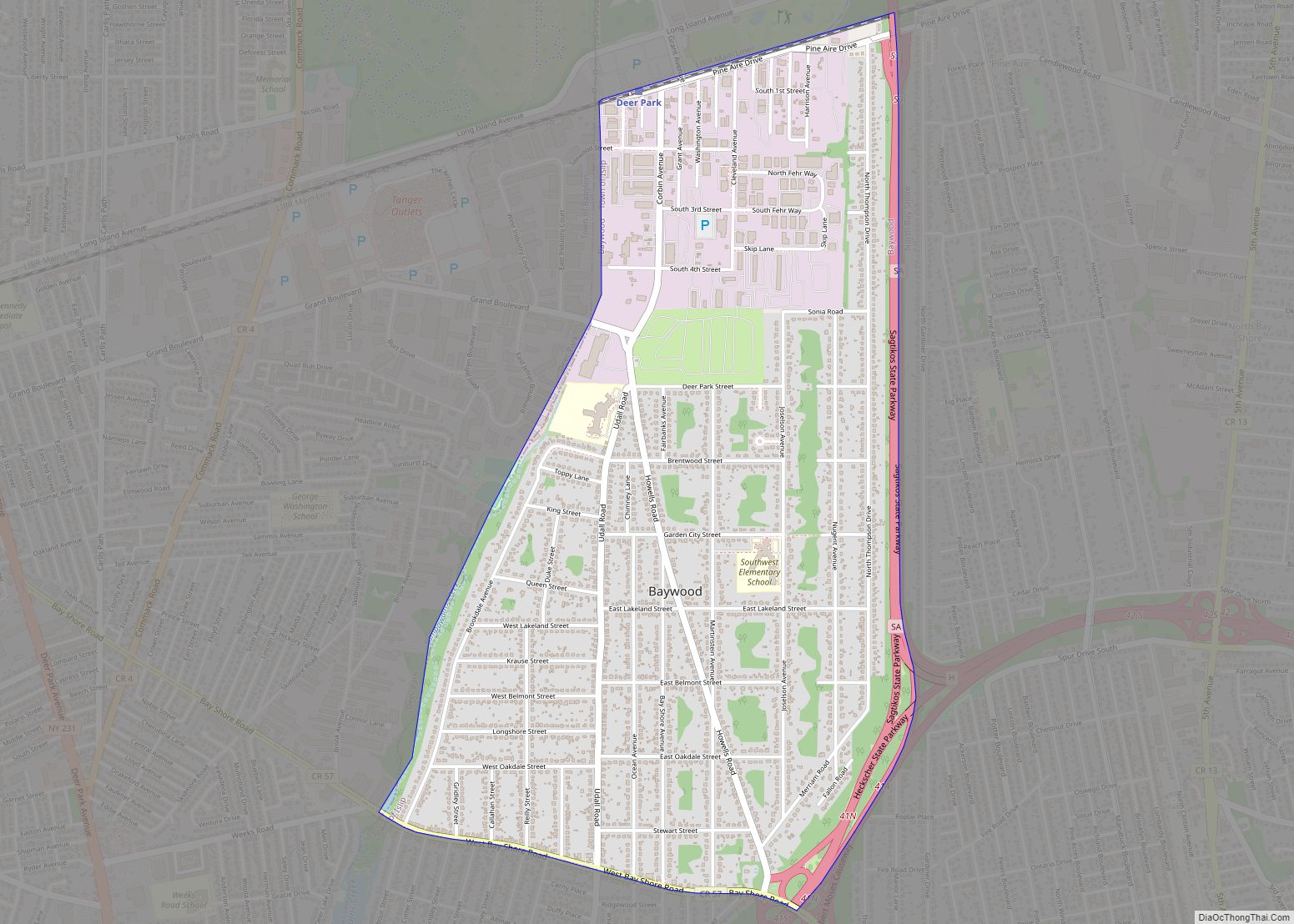Babylon is a village in Suffolk County, New York. The population was 12,166 at the 2010 census. It is located approximately 25 miles (40 km) from New York City at the Queens border and approximately 33 miles (53 km) from Manhattan.
Its official name is The Incorporated Village of Babylon. It is commonly referred to as Babylon Village, to distinguish it from the Town of Babylon, of which it is a part.
| Name: | Babylon village |
|---|---|
| LSAD Code: | 47 |
| LSAD Description: | village (suffix) |
| State: | New York |
| County: | Suffolk County |
| Incorporated: | 1893; 130 years ago (1893) |
| Elevation: | 7 ft (2 m) |
| Total Area: | 2.79 sq mi (7.24 km²) |
| Land Area: | 2.41 sq mi (6.24 km²) |
| Water Area: | 0.38 sq mi (0.99 km²) |
| Total Population: | 12,188 |
| Population Density: | 5,055.16/sq mi (1,952.09/km²) |
| ZIP code: | 11702 |
| FIPS code: | 3603408 |
| GNISfeature ID: | 0942756 |
Online Interactive Map
Click on ![]() to view map in "full screen" mode.
to view map in "full screen" mode.
Babylon location map. Where is Babylon village?
History
What is now Babylon Town and Village was originally part of Huntington Town and known as Huntington South. Lightly settled from 1689, its main industry, in common with much of the area along Great South Bay and South Oyster Bay (both actually lagoons), was the harvesting of salt hay, which was used as cattle feed and bedding.
When a coherent community grew up in the area by 1803, prominent local citizens sought to adopt a new name. An influential local lady, Mrs. Conklin, was used to living inland in what is now considered Dix Hills and was at unease with the home site that her grandchildren would be raised in. The bible-reading Mrs. Conklin compared the new hamlet to the biblical city of Babylon and proposed that name in apparent defiance of the area’s rather bawdy reputation as a stop-over place for travelers on Long Island’s south shore. Her son Nat was appalled by the use of an “unholy” name. The family legend states she replied: “But it will be a new Babylon.” The name stuck, despite some effort to change it. The adjacent part of Islip, an effective extension of Babylon, was originally considered as part of Babylon, or as East Babylon, but today is the hamlet of West Islip.
Revolutionary War through the War of 1812
Babylon had already been settled, as Huntington South, prior to hostilities with the British in the Revolutionary War. The First Presbyterian Church of Islip and Huntington South, as it was then known, was established in 1730. Though the church would later be split into two separate Huntington South and Islip churches in 1857 (the former to be renamed the First Presbyterian Church of Babylon after 1872). However, long before this split, the First Presbyterian Church held services in the original wooden church until 1778 when British soldiers tore down the structure. The wood from the first church was taken west to Hempstead to construct a barracks for British troops. This event was more recent history when, on the eve of the War of 1812, Joshua Hartt gave an impassioned sermon encouraging the young men to defend the United States and prepare for a “righteous war.”
Babylon supplied several heroes of the Revolutionary war and War of 1812, some of whom, like continental soldier David Smith who served under George Washington, are buried in the old Babylon Cemetery. Perhaps most prominent was Joel Cook, a veteran of both wars. Citizens of Babylon first honored Captain Joel Cook with a monument unveiled in 1908. Captain Cook served throughout the duration of the Revolutionary War and commanded a Company in the War of 1812. Other prominent veterans of the War of 1812 include members of the Sammis and Cooper families. Both of these families are remembered by street names in the Village today.
In July 1814, survivors of the Battle of Valparaiso were led by Captain David Porter through the Fire Island Inlet (which would have been a very difficult task using simply oars) and up to Babylon via Sumpawams Creek. Villagers were shocked to see armed sailors heading into town, and it took time to convince some of the more prominent citizens that Captain Porter was not a British agent. To convince Stephen B. Nichols, Captain Porter even offered him his cutlass and proposed to surrender to him if Nichols truly felt he was the enemy. Once thoroughly convinced of his commission as a US naval officer, villagers provided Captain Porter and his men with a carriage and horses to take them to the Brooklyn Naval Yard. It was there that Captain Porter first shared the news of the fight at Valparaiso, over four months after the engagement.
Hotels; gateway to Fire Island
Babylon soon became the primary gateway to the nearby barrier beaches, including Fire Island, a position it held until the building of the current Captree Causeways allowing automobile access to the beaches nearest the Babylon shore. Beachgoers arriving by train or coach, or staying at local hotels typically took the Babylon Railroad, originally a horsecar line and later a trolley, to the Babylon Dock for ferries to Oak Island, Muncie Island, and Fire Island destinations.
As now, the epitome of the luxury lifestyle was summering on the ocean. This led many affluent individuals and families to reside at Babylon’s seaside resorts, both on the mainland and on barrier beach islands. Muncie Island, (was just north of Oak Beach, island was depleted for the construction of Ocean Parkway) was host to one of the most elite sanatoriums and nearby Saltaire was host to the Surf Hotel offering several hundred rooms to guests. Guests of the Surf would take the rail road to Babylon’s trolley and then cross the bay by a ferry. Off Robins Avenue at Stone Dock was the South Shore Inn and Watson House on Fire Island Avenue was famed to be “L.I.’s most luxurious hotel” when it was built. Those of even greater wealth would have homes or compounds built on the shore or barrier beach islands for vacationing. Stage stop hotels include the La Grange Inn, previously used as a catering hall, and now a West Islip Historical Museum, and is actually adjacent West Islip.
Some of Babylon’s hotels included:
- American Hotel, Main Street and Fire Island Avenue
- The Argyle, Argyle Park, Main Street
- Boynes Hotel, at steamboat dock
- East End Hotel, Main Street and Cooper Street (burned in 1982)
- La Grange Inn, South Country Road, (West Islip), ***NOW CLOSED***
- St. James West Main Street
- Sherman House, East Main Street
- South Shore Inn, Robbins Avenue
- Surf Hotel, Fire Island, east of the lighthouse
- Watson House, Fire Island Avenue
Argyle Hotel & Park
The famous Argyle Hotel in Babylon was one of many built in the late 19th century to accommodate wealthy summer visitors from New York City. It was constructed in 1882 by August Belmont, the LIRR and resort entrepreneur on the former estate of Brooklyn railroad magnate Electus B. Litchfield. Financing was provided by a syndicate headed by Long Island Rail Road President, Austin Corbin. The grounds, which included a large millpond, Blythebourne Lake became renamed Argyle Lake, for one of the hotel’s largest investors and town aristocrat, the heir to the Dukedom of Argyll. The renaming gave the Hotel & Park a more genteel English flavor yet the hotel proved a bad venture: it was near the end of the era of such projects, it was built much too large with 350 rooms, and so was rarely more than one-third filled. After about a decade of disuse, it was finally demolished in 1904, with some of the material from the structure being used to build homes west of the lake in the neighborhood now known as Argyle Park. In 1921, the land that is now the Argyle Park was donated for passive recreation to the Village of Babylon, by J. Stanley Foster, Esq. This park is still popular, drawing substantial numbers of visitors from outside the community for fishing, strolling, playing on the children’s playground, and winter ice skating (including a lighted area for night skating).
Effingham Park/Hawley’s Lake Park
Effingham Park was the site of the Old Mill on what is now the Babylon Village-West Islip border and South Country Road, now Montauk Highway (Main Street in Babylon). The old mill is claimed to be the first permanent structure in the Village area and was constructed for Judge Garrett Montfort and operated by the Oakley family for approximately 100 years. Nathaniel Conklin also owned the mill and in its final years, ownership was in the hands of David Ricketts, the second mayor of the Village. Ricketts used the mill as a toy whip factory which he later relocated to George Street. At one point, a bridge was used to carry Main Street over the overflows connection to Sumpwams Creek.
The park belonged to the estate of Effingham Sutton that later came into the ownership of Edwin Hawley, a U.S. railroad tycoon. Hawley demolished the Old Mill and parts of Sutton’s Estate to erect an even more opulent estate including guest cottages, staff housing, and stables. Hawley turned the overflow from the Old Mill into a waterfall that matched and, some claim, exceeded the splendor of the still-existent Argyle Falls at Argyle Memorial Park. In addition to the falls, there were two bridges crossing the north side and mid-northeast side of the lake in many old postcards and photographs. The north side bridge was likely the bridge that carried George Street over the stream feeding Hawley’s Pond, before New York Highway 231 was put through the area.
The Hawley Estate was gated off from the public with hedges and grand ornate estate fencing so that the public rarely saw its vast luxuries and amenities. In the late 1960s the site of Hawley’s Pond was in a rundown state, being unkempt and dilapidated. When Route 231 was being built, Hawley’s Lake Park lost all hope of being repaired and restored to its former glory: the routes northern and southern terminus were run directly through the estate. Some sources even claim that the lake was made considerably smaller and was partially filled in during the expressway’s construction. Today, Hawley’s Lake Park is an unused resource due mostly for its lack of parking and lack of village concern. The aging grand falls were replaced with a more modern, less ornate and less attractive setup. The Babylon Beautification Society tries from time to time to maintain the site, although no plan has proved considerably successful. Since there is no parking at the site, and because access to families that might otherwise want to use it is constrained by the necessity of crossing active highway lanes, the current status of the site has remained unchanged. Between the park and the Lake Drives in West Islip and the northern terminus of Route 231 is a small group of ponds also belonging to the former Effingham Park. This portion is no longer designated as park property, and is accessible to the homes on Lake Drive South and Lake Drive North. The overflow pool from Hawley’s Fall opens into two tunnels beneath Main Street that drain into Sumpawams River, known locally as East Creek, and eventually into Great South Bay.
Baseball and African-American history
Many of the black service personnel of the Argyle Hotel formed a baseball team, the Babylon Black Panthers, said to be the first black professional baseball team. The team so dominated local white teams that Walter Cook, a New Jersey promoter, put up the money to have them travel and play as the “Cuban Giants.” Calling black ballplayers (or ballplayers in “white” professional clubs in that era who seemed too dark to be Caucasian) “Cuban” was a common practice through World War II. There were no Cubans in the Cuban Giants.
The team went on to become the “world colored champions” of 1887 and 1888, and spawned imitators.
Babylon Village today has three baseball fields for the high school, little league and adult play, and the high school team is named the Babylon Panthers. The Babylon Panthers varsity baseball team won Long Island championships in 2005-2006, 2012, and the New York State championship in 2007. The village also has one of Long Island’s older continuous African-American communities, of which the employees of the Argyle are said to have formed the core. This community still maintains two of the village’s 12 churches, the Ebenezer Baptist Church and the Bethel African Methodist Episcopal Church, both on Cooper Street.
Another prominent African-American, the film actress Thelma (Butterfly) McQueen, moved with her family from her birthplace of Tampa, Florida to live on Cottage Row in Babylon, where she went on to graduate from Babylon High School and then pursued her acting career before later attending several universities and attaining a degree in political science. Cottage Row still exists but no longer has any housing on it, falling prey to parking space for business district stores.
Hurricane Sandy
Many Babylon village residences and businesses suffered major flood and wind damage from Hurricane Sandy on October 29, 2012 with most of the damage occurring south of Montauk Highway (Main Street) close to the Great South Bay. This particular area experienced storm surge as high as twelve feet during the storm. Damage caused by Sandy displaced dozens of families in Babylon for several months.
Babylon Road Map
Babylon city Satellite Map
Geography
According to the United States Census Bureau, the village has a total area of 2.8 square miles (7.1 km), of which 2.4 square miles (6.2 km) is land and 0.3 square miles (0.9 km) (12.32%) is water.
Babylon Village is bordered to the west by West Babylon, to the north by North Babylon, to the east by West Islip, and to the south by the Great South Bay.
See also
Map of New York State and its subdivision:- Albany
- Allegany
- Bronx
- Broome
- Cattaraugus
- Cayuga
- Chautauqua
- Chemung
- Chenango
- Clinton
- Columbia
- Cortland
- Delaware
- Dutchess
- Erie
- Essex
- Franklin
- Fulton
- Genesee
- Greene
- Hamilton
- Herkimer
- Jefferson
- Kings
- Lake Ontario
- Lewis
- Livingston
- Madison
- Monroe
- Montgomery
- Nassau
- New York
- Niagara
- Oneida
- Onondaga
- Ontario
- Orange
- Orleans
- Oswego
- Otsego
- Putnam
- Queens
- Rensselaer
- Richmond
- Rockland
- Saint Lawrence
- Saratoga
- Schenectady
- Schoharie
- Schuyler
- Seneca
- Steuben
- Suffolk
- Sullivan
- Tioga
- Tompkins
- Ulster
- Warren
- Washington
- Wayne
- Westchester
- Wyoming
- Yates
- Alabama
- Alaska
- Arizona
- Arkansas
- California
- Colorado
- Connecticut
- Delaware
- District of Columbia
- Florida
- Georgia
- Hawaii
- Idaho
- Illinois
- Indiana
- Iowa
- Kansas
- Kentucky
- Louisiana
- Maine
- Maryland
- Massachusetts
- Michigan
- Minnesota
- Mississippi
- Missouri
- Montana
- Nebraska
- Nevada
- New Hampshire
- New Jersey
- New Mexico
- New York
- North Carolina
- North Dakota
- Ohio
- Oklahoma
- Oregon
- Pennsylvania
- Rhode Island
- South Carolina
- South Dakota
- Tennessee
- Texas
- Utah
- Vermont
- Virginia
- Washington
- West Virginia
- Wisconsin
- Wyoming
